Nestled in Lamu’s mangrove archipelago is Pate Island, a small but enchanting gem, located northeast of Lamu Island, that brims with history, natural beauty and culture. Home to a thriving Swahili community, its roots, as does the other islands in Lamu, trace back centuries. The local community takes great pride in their traditional way of life, ensuring that customs are passed down from one generation to the next.
Pate Island, the largest in the archipelago, is known for its distinctive blend of African, Arabic and Persian influences, along with its rich archaeological sites. The historic ruins of the once majestic palaces for sultans of the 15th and 16th Centuries remain, as do some mosques, stone walls and houses that were made from limestone, coral and mangroves.
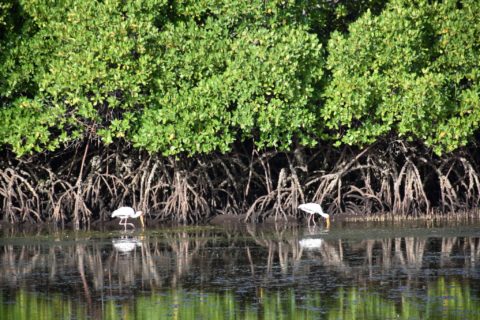
For avid birders, Pate is a haven
Pate is rich in fish variety, sea turtles and birdlife. Some people have been lucky to spot the rare dugong. And where Pate lacks a sandy beach or terrestrial wildlife, it makes up with rich marine and bird life, priceless historical and cultural heritage, and thriving mangroves.
Africa’s mangroves provide immense riches. Unfortunately, they are burdened by competing demands from people. Overexploitation is placing significant stress on these ecosystems, threatening their productivity and the potential for sustainable economic growth.
Despite centuries of harvesting, Lamu County still boasts the largest mangrove cover in Kenya, standing at 60%. The County has five mangrove management units, with Pate Island Swamps comprising Pate Island, Shindabwe, Kizingitini and Chongoni, making up 26% of Lamu’s mangroves according to the National Mangrove Ecosystem Management Plan 2017-2027.
Pate’s economic mainstay is fishing, with the fish dependent on mangroves, coral reefs and seagrasses to nest and breed, away from the harsh currents in the deeper waters. Aside from mangrove harvesting and trade, the local community can explore other sustainable ventures to supplement their revenue. This is through ecotourism ventures such as nature-based tourism, cultural or heritage tourism, and other innovative approaches.
Tourism in Pate
It takes almost an hour on a speedboat from Lamu Old Town jetty to Pate Island depending on the tides and route. During high tide, one may be lucky to sail through picturesque channels cutting through dense labyrinthic mangrove forests, with shrill cicadas tempered by bird calls filling the humid air.
Until a few years back, Pate lacked proper visitor facilities forcing tourists to opt for homestays or day trips. Most visitors during that time were either researchers or fish traders. However, since end 2019, Patte Resources and Tourism Initiative (PRATI), a community-based organisation, has been hosting day tourists at their banda. The group comprising 22 members – 14 men and 8 women – took it upon themselves to construct, with their bare hands, the banda using local materials and limited resources. The banda now serves as the nerve centre for mangrove rehabilitation, beekeeping, collection of ruins for the local museum, site seeing and shoreline conservation.
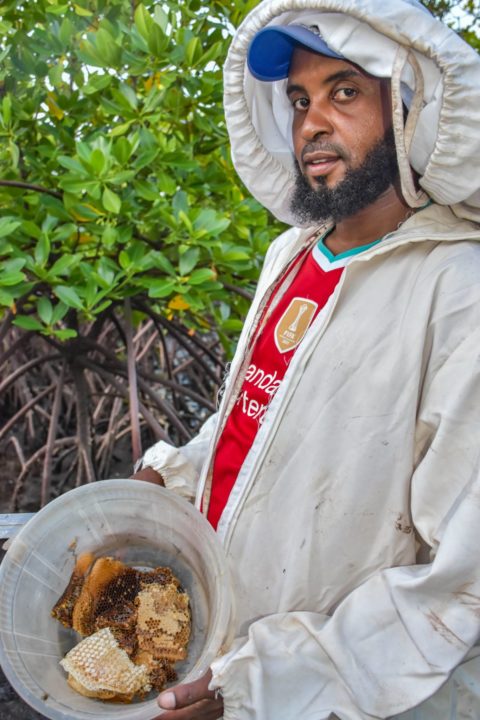
Stopa and his PRATI colleagues have been piloting beekeeping and hope to upscale for income generation
“We are driven by the need to have healthy mangroves because these forests are part and parcels of our lives. So far, we have planted 11,000 seedlings in Pate and donated 5,000 to Kenya Forest Service,” Mohamed Kassim, PRATI’s Chair and Founder, famously known by his moniker Stopa.
Stopa is born and bred in Pate. At six feet, with a heavy build and a piercing gaze, on several days a week, he swiftly shuffles barefoot between the aerial mangrove roots to check on their rehabilitation area or to speak to the bees as he collects the dark mangrove honey. On other days, he and colleagues host guests at their banda, where they regal them with Pate and Lamu’s history and culture, entertaining them with a variety of Swahili cuisine including fresh lobsters, creating an unforgettable experience.
Training and Exchange Visit
PRATI aims to enhance mangrove conservation and help improve the health, welfare and livelihood of the members through improved planning and resource management. Some of its members are also part of the Pate Beach Management Unit, further cementing their commitment to coastal resource management. In addition, the community group also trains on mangrove conservation and management to help build its members’ capacity.
“The training we had at Dabaso was a real eye-opener for PRATI. The Dabaso Group has gone through a lot of lessons over time, failed many times but they have not given up. They are now reaping the benefits of ecotourism,” he says.
Stopa is referring to a training and exchange visit conducted by Dabaso Creek Conservation Group (DCCG) at Mida Creek that six PRATI members and representatives from the Beach Management Unit Network and Lamu and Mkunumbi Community Forest Associations attended last April. Wetlands International, through the Mangrove Capital Africa programme that is funded by DOB Ecology, supported and organised the learning exchange between the two communities.
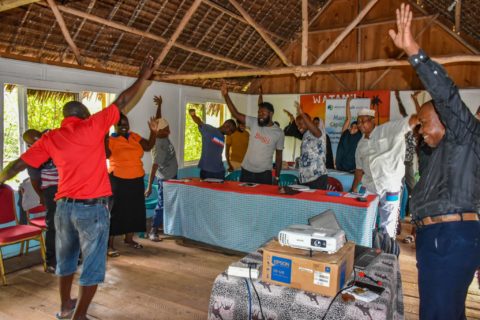
Energiser moment for trainers and trainees at Dabaso, Malindi
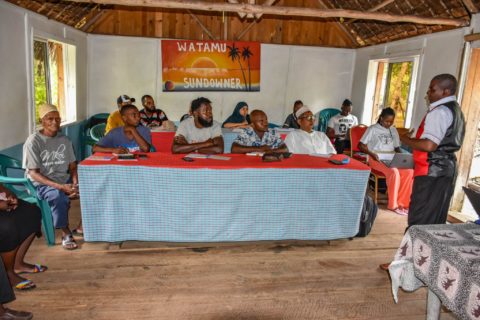
Kahindi Charo sharing experiences on ecotourism and mangrove conservation by Dabaso Creek Conservation Group
DCCG was initiated in 1999, according to the chairman Benjamin Karisa, but was officially registered in 2001. “Our goal was mangrove conservation and restoration, waste management and crab fishing. The latter was our main income-generating activity. We built our boardwalk not because of tourists, but to access the crabs. It’s been a double blessing,” he explains.
United by one language, some coastal customs and grassroots interests and fervour, Karisa and his team took the Lamu group through their history, achievements, challenges, governance, benefits resources, conflict management, the ecotourism facility which is a restaurant and boardwalk, customer care, guest relations and how to build a crab cage for farming. For the ecotourism facility, DCCG decided to invest in crab farming as they are readily available and would be their niche in the vast tourism industry in Malindi.
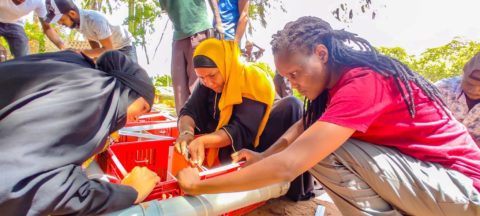
Husna Bakari (L) and Nana Nadhira (C) of PRATI with Shawlet Cherono during the practical training on crab cage building at Dabaso
PRATI reciprocated by sharing their own history, achievements, challenges and governance structures, inviting the Dabaso group to visit Pate Island for further knowledge exchanges. The latter also offered to hold PRATI’s hand during the development or expansion of the ecotourism facility in addition to much-needed advice and guidance. This collaboration reflects the shared dedication between the two community-based organisations to improve their incomes through ecotourism while conserving mangrove ecosystems.
What next?
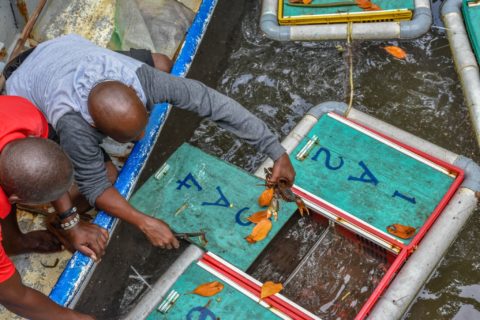
DCCG members demonstrate how to place crab in cages for their income-generation facility
“My main take away from this training is benefit sharing, governance, and the set-up of the income-generating facility. I dream of our facility having enough space to hold meetings, accommodate guests, have a dining area,” Husna Bakar, PRATI’s Vice Secretary.
Soft-spoken Nana Nadhira, who is in charge of PRATI’s kitchen, says what stood out for her was the cuisine. “In Dabaso they make crab samosas. In Pate, we have been making fish samosas but for local sale. Together with other women members, we will soon try and make crab and lobster samosas for our guests.”
After the training, the PRATI six went back to Pate and shared the new knowledge with other members and even taught them how to build a crab cage. During World Environment Day, besides spearheading a plastic collection activity in Pate Town, the resourceful group also launched their crab farming initiative and is piloting with 18 crabs. Further, they taught those in attendance how to restore degraded mangrove areas using the CBEMR approach.
In March 2022, PRATI was among seven community and civil society groups that were engaged by Wetlands International in an Organisational Capacity Assessment identifying areas for improvement such as governance, resource sharing, conflict management, ecotourism management, bookkeeping, marketing, and guest relations. This assessment prompted the collaboration and the need to build PRATI’s capacity.
PRATI has been granted a special use licence by KFS to carry out development activities within a forest reserve. “We are now working toward developing the ecotourism facility encompassing a bird observation area, boardwalk, resource centre, accommodation facilities, mangrove restoration area and fish farms,” states Shawlet Cherono, Wetlands International Project Officer.
“Our guests can engage in a variety of activities including snorkeling, getting their hands and feet dirty in the mangroves to learn about their value and what we can do together to safeguard them. We can also take them on guided nature walks to watch birds during sunsets or just enjoy the mangrove ambience,” adds Stopa.
Lead image: PRATI’s banda in Pate Island

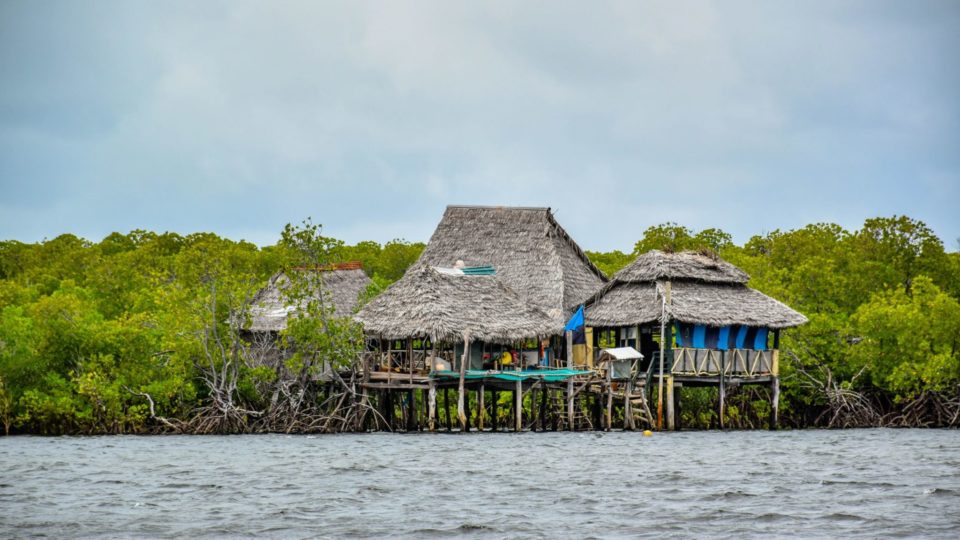
Leave a comment